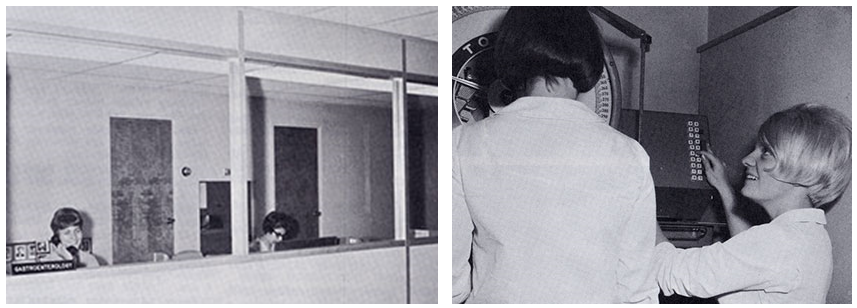-
#FlashbackFriday 1967: Gastroenterology On the Move

This article first appeared July 28, 1967, in the publication Mayovox.
The Gastroenterology Unit, headed by Dr. William H. J. Summerskill, now in its sixth year, this month moved to an area on the second floor in Saint Marys Alfred Unit. Since 1962 the unit had occupied rooms on second floor in the tower section of the hospital. The new location provides vastly enlarged and improved facilities.
The photographs below give only a partial view of the unit which occupies nearly 7,000 square feet of the second floor area. It provides:
- A patient study area with four beds for patients undergoing “acute” studies, of one to four hours’ duration. Patients in whom more extensive studies (up to three weeks) are undertaken are hospitalized in the Clinical Study Unit which now is located on first floor of the Alfred Unit, or elsewhere in the hospital.
- Laboratories with a full range of biochemical facilities and providing a high degree of versatility. Among these are a cold room for enzyme studies and a constant temperature room. Isotope facilities include counters and read-out equipment for determination of uptake and excretion of radioactive substances.
- An x-ray facility which provides fluoroscope with image intensification, cineradiography and television monitoring.
- Offices for staff, patient examining room, consultation rooms, secretarial area, conference rooms.
- A library-conference room for the unit’s teaching program.



Staff, in addition to Dr. Summerskill, includes Drs. L. J. Schoenfield, W. P. Baldus, A. F. Hofmann, S. F. Phillips and D. C. McIlrath. Dr. Hofmann spends all of his time in the unit, Dr. Summerskill a major portion of his time and the other consultants 50 per cent or more of their time. Drs. Summerskill, Schoenfield, Baldus and Phillips are also members of clinical sections. Dr. McIlrath is a member of a general surgical section and also of the Section of Surgical Research.
From 10 to 12 residents are usually working in the unit. Paramedical staff number eight. Nurse supervisor is Betty Lee Stubbs.
Research, which is the major activity of the unit’s staff, is aimed at elucidation of mechanisms of abdominal diseases and their treatment. Studies relate to structure and function of all parts of the gastrointestinal tract, as well as those of the liver, biliary system and pancreas. Each staff member has completed or underway a number of studies, frequently in collaboration with other members of the Clinic staff. Projects completed or underway number more than one hundred.
The research program is supported in part by NIH grants, as is the extensive gastroenterology training program. Construction of the portion of the Alfred Unit devoted to research also has received grant support.
The impressive facilities now available to the Gastroenterology Unit are “no greater than are needed in an institution which has commitments to education and research as well as to patient care,” Dr. Summerskill states. The unit does represent, he says, “the most advanced attempt to integrate clinical research with teaching and subspecialty practice within the institution and is the first unit in which clinicians are primarily responsible for research.” Other specialty groups he believes, will develop comparable facilities and “our unit may become the prototype on which some of these new facilities may be modeled.”
The number of patients with gastrointestinal disease seen at the Clinic (which exceeds number of patients with any other single complaint) emphasizes the need, and provides the opportunity, for studies on the cause and course of the disease and on possible methods of treatment.
“Our ultimate aim,” Dr. Summerskill says, “is to develop a group wherein specialists with different skills are grouped round the patient with a relevant disease.” Fortunately, he notes, “we have been able to train or recruit staff with ability and potential in research.”







